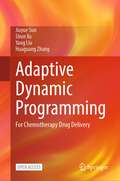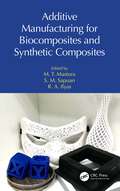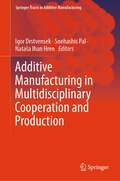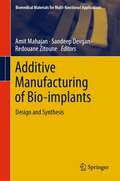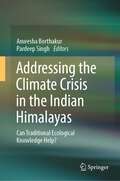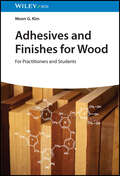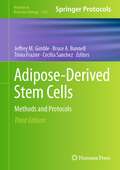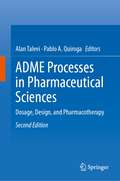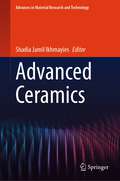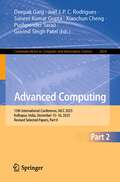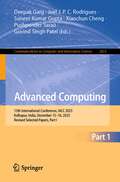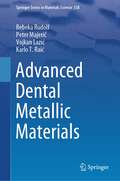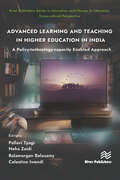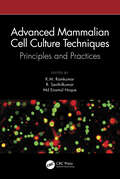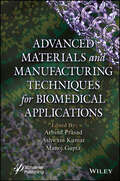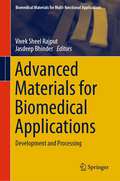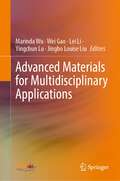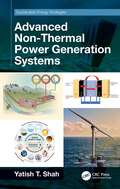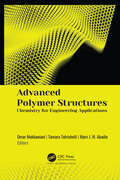- Table View
- List View
Adaptive Dynamic Programming: For Chemotherapy Drug Delivery
by Jiayue Sun Shun Xu Yang Liu Huaguang ZhangThis open access book focuses on the practical application of Adaptive Dynamic Programming (ADP) in chemotherapy drug delivery, taking into account clinical variables and real-time data. ADP's ability to adapt to changing conditions and make optimal decisions in complex and uncertain situations makes it a valuable tool in addressing pressing challenges in healthcare and other fields. As optimization technology evolves, we can expect to see even more sophisticated and powerful solutions emerge.
Additive Manufacturing for Biocomposites and Synthetic Composites
by M. T. Mastura S. M. Sapuan R. A. IlyasAdditive Manufacturing for Biocomposites and Synthetic Composites focuses on processes, engineering, and product design applications of bio-composites and synthetic composites in additive manufacturing (AM). It discusses the preparation and material characterization and selection, as well as future opportunities and challenges. Reviews the latest research on the development of composites for AM and the preparation of composite feedstocks Offers an analytical and statistical approach for the selection of composites for AM, including characterization of material properties Emphasizes the use of environmentally friendly composites Analyzes the lifecycle including costs Considers potential new fibers, their selection, and future applications This book provides a comprehensive overview of the application of advanced composite materials in AM and is aimed at researchers, engineers, and advanced students in materials and manufacturing engineering and related disciplines.
Additive Manufacturing for Biocomposites and Synthetic Composites
by M. T. Mastura S. M. Sapuan R. A. IlyasAdditive Manufacturing for Biocomposites and Synthetic Composites focuses on processes, engineering, and product design applications of bio-composites and synthetic composites in additive manufacturing (AM). It discusses the preparation and material characterization and selection, as well as future opportunities and challenges. Reviews the latest research on the development of composites for AM and the preparation of composite feedstocks Offers an analytical and statistical approach for the selection of composites for AM, including characterization of material properties Emphasizes the use of environmentally friendly composites Analyzes the lifecycle including costs Considers potential new fibers, their selection, and future applications This book provides a comprehensive overview of the application of advanced composite materials in AM and is aimed at researchers, engineers, and advanced students in materials and manufacturing engineering and related disciplines.
Additive Manufacturing in Multidisciplinary Cooperation and Production (Springer Tracts in Additive Manufacturing)
by Igor Drstvensek Snehashis Pal Nataša Ihan HrenThis book publishes the latest findings and ideas in the field of additive manufacturing presented by authors from prominent institutions around the world at the iCAT 2023 conference. The authors address various technological and medical aspects, ranging from materials science to the specific behaviour of the technology under different working conditions. The book is divided into four sections, three of which are dedicated to the purely technological aspects of additive manufacturing, covering metal processes, polymer processes and simulation. The fourth part of the book is dedicated to the medical applications of additive manufacturing, covering areas ranging from orthopaedic surgeries to materials used in medical AM.Overall, the book provides insight into the current state of the science and applications of additive manufacturing.
Additive Manufacturing of Bio-implants: Design and Synthesis (Biomedical Materials for Multi-functional Applications)
by Amit Mahajan Sandeep Devgan Redouane ZitouneThis contributed volume presents the latest research on additive manufacturing (AM) or 3D printing, one of the key techniques of novel medical devices, which can process complicated or customized structures to match the properties of human tissues. AM allows for the fabrication of devices with optimal architectures, complicated morphologies, surface integrity, and regulated porosity and chemical composition. Various AM methods can now consistently fabricate dense products for a variety of materials, comprising steels, titanium alloys, Co-Cr alloys, metal-based composites, and nanocomposites. This book elucidates the chronology of various techniques that are categorized under additive manufacturing. Moreover, the futuristic techniques or advancements in this area are also described. The available literature focuses on the microstructure and various properties of 3D-printed alloys. However, the research on the wear characteristics, corrosion resistance, and biocompatibility of 3D-printed technology for biomedical applications is limited. This book comprises the helicopter view of different surface analysis trends of additive manufactured alloys. The book can be a valuable reference for beginners, researchers, and professionals interested in bioimplant manufacturing and allied fields.
Addressing the Climate Crisis in the Indian Himalayas: Can Traditional Ecological Knowledge Help?
by Anwesha Borthakur Pardeep SinghThis book focuses on the traditional ecological knowledge in addressing the current climate crisis in the Indian Himalayas. Local or indigenous people in the Himalayas, through their low-carbon producing lifestyles, contribute very little to the climate crisis. However, at the same time, they bear the brunt of this crisis way more than many others. It is important to learn about their traditional ways of life and the knowledge that they hold regarding ecology and environment. Traditional ecological knowledge and associated belief systems are given increasing attention across the globe in recent times toward addressing some of the grave environmental concerns. Climate change is one such concern. The rising consideration of concepts such as ethnoecology and ethnobotany signifies the scientific, socio-cultural and economic potential of the traditional ecological knowledge systems. It is indisputable that these knowledge systems have the ability to provide important insights towards tackling many present-day environmental distresses including several climate change challenges. In this book, the authors concentrate on such traditional ecological knowledge systems in the Indian Himalayan region and try to figure out their significance in relation to the modern science. Overall, the authors attempt to write a book where the relevance of traditional ecological knowledge systems could be addressed and communicated to a larger audience—both academic scientific and non-academic.
Adhesives and Finishes for Wood: For Practitioners and Students
by Moon G. KimAdhesives and Finishes for Wood Understand the science of joining wood with this comprehensive guide Long seen as an old-fashioned material with narrowing modern applications, wood has seen increased popularity as a material in building and manufacturing in recent years. This has been driven by the need for sustainable resources and environmentally friendly materials. As a result of increased emphasis on wood, however, there is a corresponding need to understand the wood adhesives, the crucial materials in wood-based manufacture and craftsmanship. Adhesives and Finishes for Wood meets this need with a comprehensive but accessible introduction to the chemistry and applications of wood adhesives. Its easy-to-follow presentation nonetheless presents wood adhesives and finishes in significant detail. Ideal for readers without considerable preexisting knowledge in chemistry, this book includes everything the reader needs to understand and apply wood adhesives in their work or industry. Adhesives and Finishes for Wood readers will also find: Coverage ranging from the fundamentals of wood adhesive polymer chemistry to the properties of specific wood structures and resins A presentation suitable for both academic students and wood manufacture professionals An author with decades of experience in both academia and industry Adhesives and Finishes for Wood is a useful reference for advanced students and professionals in industries or manufacturing disciplines that incorporate wood, as well as for chemists, materials scientists, vocational school instructors, and more.
Adhesives and Finishes for Wood: For Practitioners and Students
by Moon G. KimAdhesives and Finishes for Wood Understand the science of joining wood with this comprehensive guide Long seen as an old-fashioned material with narrowing modern applications, wood has seen increased popularity as a material in building and manufacturing in recent years. This has been driven by the need for sustainable resources and environmentally friendly materials. As a result of increased emphasis on wood, however, there is a corresponding need to understand the wood adhesives, the crucial materials in wood-based manufacture and craftsmanship. Adhesives and Finishes for Wood meets this need with a comprehensive but accessible introduction to the chemistry and applications of wood adhesives. Its easy-to-follow presentation nonetheless presents wood adhesives and finishes in significant detail. Ideal for readers without considerable preexisting knowledge in chemistry, this book includes everything the reader needs to understand and apply wood adhesives in their work or industry. Adhesives and Finishes for Wood readers will also find: Coverage ranging from the fundamentals of wood adhesive polymer chemistry to the properties of specific wood structures and resins A presentation suitable for both academic students and wood manufacture professionals An author with decades of experience in both academia and industry Adhesives and Finishes for Wood is a useful reference for advanced students and professionals in industries or manufacturing disciplines that incorporate wood, as well as for chemists, materials scientists, vocational school instructors, and more.
Adipose-Derived Stem Cells: Methods and Protocols (Methods in Molecular Biology #2783)
by Jeffrey M. Gimble Bruce A. Bunnell Trivia Frazier Cecilia SanchezSince the publication of the previous editions, there has been increased focus on the use of adipose-derived stromal/stem cells (ASC) and stromal vascular fraction (SVF) cells in three-dimensional hydrogel-based scaffolds for the development of microphysiological systems (MPS) serving as in vitro humanized assays and alternatives to in vivo pre-clinical animal models. This third edition volume discusses of the latest technology and advancements in the field of human-derived ASC and SVF. The chapters in this book are organized into four parts. Part One focuses on human ASC’s isolation, characterization, and differentiation. Part Two describes the isolation and characterization of ASC and SVF from canine, feline, and murine tissues. Part Three looks at hydrogels, scaffolds, and microphysiological systems, and Part Four talks about the new assays and applications using ASC. Written in the highly successful Methods in Molecular Biology series format, chapters include introductions to their respective topics, lists of the necessary materials and reagents, step-by-step, readily reproducible laboratory protocols, and tips on troubleshooting and avoiding known pitfalls.Cutting-edge and comprehensive, Adipose-Derived Stem Cells: Methods and Protocols, Third Edition is a valuable resource for both novice and experts researchers interested in learning more about this important and developing field.
ADME Processes in Pharmaceutical Sciences: Dosage, Design, and Pharmacotherapy
by Alan Talevi Pablo A. QuirogaAbsorption, Distribution, Metabolism and Excretion (ADME) processes and their relationship with the design of dosage forms and the success of pharmacotherapy form the basis of this upper level undergraduate/graduate textbook. Whereas primarily oriented to Pharmacy students and graduates, it can also be useful for scientist from different fields elated to pharmaceutics and pharmacology. (e.g., material scientists, material engineers, medicinal chemists, physicians) who might be working in a positions in pharmaceutical companies or whose work might benefit from basic training in the ADME concepts and related biological background.Pedagogical features such as objectives, keywords, discussion questions, summaries and case studies are included as teaching tools. This book will provide not only general knowledge on ADME processes but also an updated insight on some hot topics such as drug transporters, multi-drug resistance related to pharmacokinetic phenomena, last generation pharmaceutical carriers (nanopharmaceuticals), in vitro and in vivo bioequivalence studies, biopharmaceuticals, pharmacogenomics, drug-drug and food-drug interactions, in silico and in vitro prediction of ADME properties, or chronopharmacokinetic. In comparison with other similar textbooks, around half of the volume would be focused on the relationship between expanding scientific fields and ADME processes. Each of these burgeoning fields has a separate chapter in the second part of the volume, and is written with experts on the correspondent topic, including industrial scientists and academics from USA and UK.Additionally, each of the initial chapters dealing with the generalities of drug absorption, distribution, metabolism and excretion would include relevant, classic examples related to each topic with appropriate illustrations. ADME Processes and Pharmaceutical Sciences is written as a core textbook for courses on pharmaceutical sciences: pharmacology, pharmacokinetics,drug delivery, biopharmaceutics, drug design and medicinal chemistry courses.
Advanced Ceramics (Advances in Material Research and Technology)
by Shadia Jamil IkhmayiesThis book presents the fundamentals of advanced ceramics, their stages of development, types and classifications, advanced processing techniques, properties, sintering, and new forms of applications. It highlights specific examples such as alumina, zirconia, Mg-Al-spinels, silicon carbide, silicon nitride, ceramic composites, and thin films with their specific applications. The book reviews progress in perovskite ceramics, in which the synthesis, processing, characterization, and advanced applications of perovskite ceramics are all thoroughly discussed. In addition, developments of perovskite solar cells, the main factors affecting their stability, current problems, development prospects in the research, and application of perovskite solar cells are all highlighted. This book also includes a review of a particular class of rare-earth-based mixed-metal oxides, namely Ln2B2O7 nanostructures (B = Zr, Sn, and Ce), where advantages and disadvantages of each production technique are addressed along with the properties of as-produced nanostructures. The solar photocatalytic uses of Ln2B2O7 nanostructures such as photodegradation of contaminants are also discussed. Yttria-based transparent ceramics for photonic applications are reviewed, along with a discussion of powder synthesis, green body preparation, sintering, and optical properties. In addition, the fundamentals of electrophoretic deposition of hydroxyapatite incorporated composite coatings on metallic substrates are presented and discussed. The different types of ceramics-based self-healing coatings and their fabrication processes have also been reported and discussed in this book. These include titania, zirconia, titanium-alumina, and zirconia-alumina incorporated with Benzotriazole (BTA) as an inhibitor. Advanced ceramic materials that have been used for the purpose of wastewater treatment including ceramic sorbents, resins, aerosols, and ceramic membranes that have been widely used for wastewater treatment purposes are also discussed in depth.Moreover, the book presents the preparation of geopolymers by microwave treatments and explains how their properties can be tuned using microwaves. Furthermore, the future and perspective of these advanced ceramic materials and their modifications to ensure better efficacy toward environmental remediation purposes are highlighted in this book.
Advanced Computing: 12th International Conference, Iacc 2022, Hyderabad, India, December 16-17, 2022, Revised Selected Papers, Part Ii (Communications In Computer And Information Science Ser. #1782)
by Deepak Garg Joel J. P. C. Rodrigues Suneet Kumar Gupta Xiaochun Cheng Pushpender Sarao Govind Singh PatelAdvanced Computing: 12th International Conference, Iacc 2022, Hyderabad, India, December 16-17, 2022, Revised Selected Papers, Part Ii (Communications In Computer And Information Science Ser. #1782)
by Deepak Garg Joel J. P. C. Rodrigues Suneet Kumar Gupta Xiaochun Cheng Pushpender Sarao Govind Singh PatelAdvanced Dental Metallic Materials (Springer Series in Materials Science #338)
by Rebeka Rudolf Peter Majerič Vojkan Lazić Karlo T. RaićThis book delivers a broad and concise look at advanced metallic materials used for dental applications. Due to their excellent mechanical and biological properties, the use of metallic materials in dentistry has continued since time immemorial. In that sense, this book aims to bring the readers closer to the specific purpose of dental metallic materials meeting specific criteria and materials properties such as biocompatibility, non-toxicity, resistance to corrosion, long-term durability, appropriate strength and toughness, as well as corresponding values of modulus of elasticity. Following a comprehensive introduction to the field, the book discusses topical issues such as the long-term stability of dental titanium implants, processing of cobalt-chrome dental alloys, emerging gold dental alloys, and novel nanofoils used for dental joining. Featuring numerous illustrative examples of experimental outcomes, this book is an ideal resource for materials scientists and metallurgists working on advanced alloys for dental applications.
Advanced Learning and Teaching in Higher Education in India: A Policy-technology-capacity Enabled Approach
This book comprehensively covers the evolution of advanced learning pedagogy and innovative technologies like open educational resources and blended learning models. It specifically talks about the future of technology-enhanced learning and how advanced technology and government policies together are trying to impact learning outcomes globally. Nowadays in a flexible learning environment, technology plays a significant role in higher education systems. Both educators and students are playing prominent roles in its successful implementation. Advanced learning pedagogy by using technology has not only changed teaching procedures but has also evolved the relationship among multiple stakeholders.The content of the book is neatly segregated into four parts. Part I covers the concept and evolution of digital learning and education technology. This part examines the role of technology in higher education and proposes a toolkit for personalized learning and continuous assessment.Parts II and III creatively represent the innovative teaching techniques and learning models under advance learning pedagogy. Chapters under parts II and III are specially designed to present the more simplistic view of various technology-based advanced learning models and resources like flipped classes, gaming designs for e-learning, etc. Part III of the book also extensively covers various case studies/instructor’s stories of technology enabled learning experiences.Part IV focuses on the evaluation of advance learning pedagogy and tools. It also covers the future of information in learning (like formative analytics) and improved learning outcomes using technology and government initiatives in the form of various future oriented education policies like the Digital Action Education Plan (2021–2027).The wide-ranging content also covers the challenges of implementation of advanced learning pedagogy and offers recommendations to overcome such challenges. The book will grab the attention of the modern (IT-enabled) instructor’s fraternity, and students and researchers in the area of technology and education. The book can be further used by policymakers and educational-technology startups to formulate and design technology-based higher education teaching policies and procedures which are indeed helpful in measuring learning outcomes.
Advanced Learning and Teaching in Higher Education in India: A Policy-technology-capacity Enabled Approach
by Pallavi Tyagi Neha Zaidi Balamurgan Balusamy Celestine IwendiThis book comprehensively covers the evolution of advanced learning pedagogy and innovative technologies like open educational resources and blended learning models. It specifically talks about the future of technology-enhanced learning and how advanced technology and government policies together are trying to impact learning outcomes globally. Nowadays in a flexible learning environment, technology plays a significant role in higher education systems. Both educators and students are playing prominent roles in its successful implementation. Advanced learning pedagogy by using technology has not only changed teaching procedures but has also evolved the relationship among multiple stakeholders.The content of the book is neatly segregated into four parts. Part I covers the concept and evolution of digital learning and education technology. This part examines the role of technology in higher education and proposes a toolkit for personalized learning and continuous assessment.Parts II and III creatively represent the innovative teaching techniques and learning models under advance learning pedagogy. Chapters under parts II and III are specially designed to present the more simplistic view of various technology-based advanced learning models and resources like flipped classes, gaming designs for e-learning, etc. Part III of the book also extensively covers various case studies/instructor’s stories of technology enabled learning experiences.Part IV focuses on the evaluation of advance learning pedagogy and tools. It also covers the future of information in learning (like formative analytics) and improved learning outcomes using technology and government initiatives in the form of various future oriented education policies like the Digital Action Education Plan (2021–2027).The wide-ranging content also covers the challenges of implementation of advanced learning pedagogy and offers recommendations to overcome such challenges. The book will grab the attention of the modern (IT-enabled) instructor’s fraternity, and students and researchers in the area of technology and education. The book can be further used by policymakers and educational-technology startups to formulate and design technology-based higher education teaching policies and procedures which are indeed helpful in measuring learning outcomes.
Advanced Mammalian Cell Culture Techniques: Principles and Practices
This up-to-date book compiles both basic and advanced laboratory techniques of mammalian cell culture. It is divided into four major sections encompassing the basics of cell culture, nucleic acid and protein isolation, cell-staining techniques, and cell transfection and single-cell analysis. The topics include aseptic handling, media preparation, and passaging of cells. The book also outlines downstream assays such as nucleic acid and protein isolation from in-vitro cell cultures. Key Features: • Covers cellular staining using fluorescent dyes, genetic manipulation of cells via transfection, and an introduction to single-cell analyses • Discusses basics in cell culture and downstream applications including gene and protein expression analysis • Includes the principles underlying each of the techniques and provides a detailed methodology to practice • Explores the whole range of techniques – from basic to downstream applications and advanced methods The book is essential for students and researchers in the field of life sciences, biotechnology, genetics, and molecular biology.
Advanced Mammalian Cell Culture Techniques: Principles and Practices
by K. M. Ramkumar R. Senthilkumar Md Enamul HoqueThis up-to-date book compiles both basic and advanced laboratory techniques of mammalian cell culture. It is divided into four major sections encompassing the basics of cell culture, nucleic acid and protein isolation, cell-staining techniques, and cell transfection and single-cell analysis. The topics include aseptic handling, media preparation, and passaging of cells. The book also outlines downstream assays such as nucleic acid and protein isolation from in-vitro cell cultures. Key Features: • Covers cellular staining using fluorescent dyes, genetic manipulation of cells via transfection, and an introduction to single-cell analyses • Discusses basics in cell culture and downstream applications including gene and protein expression analysis • Includes the principles underlying each of the techniques and provides a detailed methodology to practice • Explores the whole range of techniques – from basic to downstream applications and advanced methods The book is essential for students and researchers in the field of life sciences, biotechnology, genetics, and molecular biology.
Advanced Materials and Manufacturing Techniques for Biomedical Applications (Advances In Manufacturing, Design And Computational Intelligence Techniques Ser.)
by Arbind Prasad Ashwani Kumar Manoj GuptaADVANCED MATERIALS and MANUFACTURING TECHNIQUES for BIOMEDICAL APPLICATIONS The book provides essential knowledge for the synthesis of biomedical products, development, nanomaterial properties, fabrication processes, and design techniques for different applications, as well as process design and optimization. In origin, biomaterials can come from nature or be synthesized in the laboratory with a variety of approaches that use metals, polymers, ceramic, or composite materials. They are often used or adapted for various biomedical applications. Biomaterials are commonly used in scaffolds, orthopedic, wound healing, fracture fixation, surgical sutures, artificial organ developments, pins and screws to stabilize fractures, surgical mesh, breast implants, artificial ligaments and tendons, and drug delivery systems. The sixteen chapters in Advanced Materials and Manufacturing Techniques in Biomedical Applications cover the synthesis, processing, design, manufacturing, and characterization of advanced materials; self-healing, bioinspired, nature-resourced, nanobiomaterials for biomedical applications; and manufacturing techniques such as rapid prototyping, additive manufacturing, etc. Audience The book is for engineers, technologists, and researchers working in the area of biomedical engineering and manufacturing techniques. It is also appropriate for upper-level undergraduate and graduate students.
Advanced Materials for Biomedical Applications: Development and Processing (Biomedical Materials for Multi-functional Applications)
by Vivek Sheel Rajput Jasdeep BhinderThis book provides an insight into the basic fundamentals of the biomaterials used for the biomedical applications, their development and processing techniques. Advanced materials are significantly utilized for the biomedical applications ranging from dental devices to cancer treatment owing to their higher biocompatibility and better interaction with tissues. This book covers the various topics that include basic biocompatibility phenomena, insight to materials science, class of different advanced materials as a biomaterials, development and processing techniques, design and analysis of the developed advanced materials, investigation of its properties and major applications. Recent information regarding the development techniques and methods for improving the properties of the advanced materials in the field of biomedical applications is highlighted in detail. The textbook offers clear explanation of the text in the chapters with self-explanatory figures and tables. It demonstrates the novel methods, opportunities and ideas for developing biomaterials in the field of biomedical applications. It also includes critical review study of the developed advanced materials for biomedical applications in a new summarized form. The inclusion of the discussions on hybrid polymer-based composites and self-healing composite materials offers a special feature in the textbook. It features a thorough overview of the simulation aspect in the biomedical applications. The book features at least 50% of its references from last three–four years’ work in the field of biomaterials and biomedical. The book content adds to the redundancy in the literature work related to biomedical and biomaterials.This book is a valuable resource for academicians, students and scholars from science and engineering background having interest in biomaterials. It is helpful to the biomedical engineering group especially in countries or location where they don’t have access to the major journals.
Advanced Materials for Multidisciplinary Applications
by Marinda Wu Wei Gao Lei Li Yingchun Lu Jingbo Louise LiuThis book provides an overview of recent research in the area of advanced materials for improving human healthcare, protecting the environment and alternative energy resources. The authors analyze and deliver viable technical solutions, demonstrating how chemistry and engineering can collectively solve technical and societal challenges. The book explores innovative technology for the synthesis of complex carbohydrates & glycoproteins, new drug development & delivery, theragnostics of infectious disease and cancer. It also provides insights into the nature of energy extraction, management and usage related to fossil fuels and sustainable energy. The book brings together a group of dynamic and productive scientists, engineers, and other professionals in celebration of the 40th Anniversary of Chinese American Chemical Society. It is a valuable resource for all readers interested in the study of materials to address society's increasing need for electrical and chemical energy.
Advanced Non-Thermal Power Generation Systems (Sustainable Energy Strategies)
by Yatish T. ShahGenerally, sources for power generation are broken down into two categories: thermal and non-thermal. Thermal sources for power generation include combustion, geothermal, solar, nuclear, and waste heat, which essentially provide heat as a means for power generation. This book examines non-thermal (mechanical, electrochemical, nanoscale self-powered, and hybrid) sources of power generation and emphasizes recent advances in distributed power generation systems. Key Features Details recent advances made in wind power, including onshore, offshore, fixed and floating platform, and air wind energy systems, and offers detailed assessments of progress Covers advances in generation of hydropower, exploring dam hydropower, novel wave energy converters, and novel systems and turbines for hydrokinetic energy conversion to power Examines all types of fuel cells and their multi-functional roles, along with hybrid fuel cell systems in complete detail Explores advances in the development of self-powered nanogenerators for use in portable, wearable, and implantable power electronics Focuses on technologies with the best commercial possibilities and provides perspectives on future challenges that need to be solved This book will be of value to all researchers in academia, industry, and government interested in pursuing power generation technologies and seeking a comprehensive understanding of available and emerging non-thermal power generation sources. Readers who are interested in learning about thermal power generation sources can find it in the author’s companion text Advanced Power Generation Systems: Thermal Sources (2023).
Advanced Non-Thermal Power Generation Systems (Sustainable Energy Strategies)
by Yatish T. ShahGenerally, sources for power generation are broken down into two categories: thermal and non-thermal. Thermal sources for power generation include combustion, geothermal, solar, nuclear, and waste heat, which essentially provide heat as a means for power generation. This book examines non-thermal (mechanical, electrochemical, nanoscale self-powered, and hybrid) sources of power generation and emphasizes recent advances in distributed power generation systems. Key Features Details recent advances made in wind power, including onshore, offshore, fixed and floating platform, and air wind energy systems, and offers detailed assessments of progress Covers advances in generation of hydropower, exploring dam hydropower, novel wave energy converters, and novel systems and turbines for hydrokinetic energy conversion to power Examines all types of fuel cells and their multi-functional roles, along with hybrid fuel cell systems in complete detail Explores advances in the development of self-powered nanogenerators for use in portable, wearable, and implantable power electronics Focuses on technologies with the best commercial possibilities and provides perspectives on future challenges that need to be solved This book will be of value to all researchers in academia, industry, and government interested in pursuing power generation technologies and seeking a comprehensive understanding of available and emerging non-thermal power generation sources. Readers who are interested in learning about thermal power generation sources can find it in the author’s companion text Advanced Power Generation Systems: Thermal Sources (2023).
Advanced Polymer Structures: Chemistry for Engineering Applications
Taking an interdisciplinary approach, this new book considers state-of-the-art developments and research in polymer science, such as advanced polymers, composites and nanocomposites, and the role of polymers in the progress of green chemistry and medicine. Polymers are studied in fields as diverse as polymer science (polymer chemistry and polymer physics), biophysics, biochemistry, and more generally in materials science and engineering. Polymer matrix composites (PMCs) and nanocomposites (PMNCs) are widely used in hightech material structures such as in the automotive, marine, and aerospace industries. Their impact on the physical and mechanical performance is mainly due to their reinforcing agents, fibers (glass, carbon, aramid) or nanofibers (MMT, CNTs, graphene, etc) but also due to a perfect mastery of the matrix/reinforcement interface.
Advanced Polymer Structures: Chemistry for Engineering Applications
by Omar Mukbaniani Tamara Tatrishvili Marc Jean M. AbadieTaking an interdisciplinary approach, this new book considers state-of-the-art developments and research in polymer science, such as advanced polymers, composites and nanocomposites, and the role of polymers in the progress of green chemistry and medicine. Polymers are studied in fields as diverse as polymer science (polymer chemistry and polymer physics), biophysics, biochemistry, and more generally in materials science and engineering. Polymer matrix composites (PMCs) and nanocomposites (PMNCs) are widely used in hightech material structures such as in the automotive, marine, and aerospace industries. Their impact on the physical and mechanical performance is mainly due to their reinforcing agents, fibers (glass, carbon, aramid) or nanofibers (MMT, CNTs, graphene, etc) but also due to a perfect mastery of the matrix/reinforcement interface.
